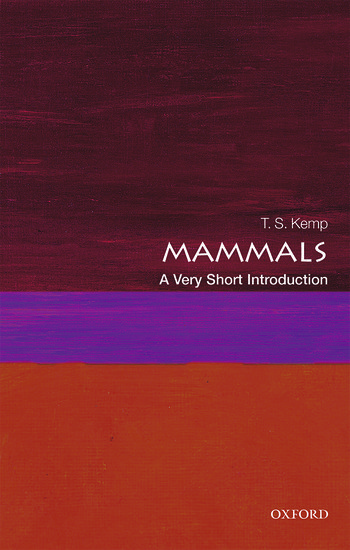Home >
A Very Short Introduction >
Mammals (Biology)
A Very Short Introduction | Biology
Mammals
ISBN: 9780198766940
Series: A Very Short Introduction
Mammals (Biology)
A Very Short Introduction Mammals (Biology) Media > Books > Non-Fiction > Education Books Expect Delays of Up to 4 Weeks| Order Below |
ISBN
9780198766940 (10-digit ISBN: 0198766947)
- Description
- Key Features
- Series Description
- Table of Contents
- Introduces the nature, evolutionary history, and modern diversity of mammals
- Considers how one of the defining characteristics of mammals, their warm bloodedness, has affected their physiology and enabled them to adapt to a wide variety of environments.
- Discusses the evidence in the fossil record for the origin and spread of mammals, showing how fossils illustrate patterns of evolution.
From a modest beginning in the form of a little shrew-like, nocturnal, insect eating ancestor that lived 200 million years ago, mammals evolved into the huge variety of different kinds of animals we see today. Many species are still small, and follow the lifestyle of the ancestor, but others have adapted to become large grazers and browsers, like the antelopes, cattle, rhinos, and elephants, or the lions, hyaenas, and wolves that prey upon them. Yet others evolved to be specialist termite eaters able to dig into the hardest mounds, or tunnel creating burrowers, and a few took to the skies as gliders and the bats. Many live partly in the water, such as otters, beavers, and hippos, while whales and dugongs remain permanently in the seas, incapable of ever emerging onto land.In this Very Short Introduction T. S. Kemp explains how it is a tenfold increase in metabolic rate - endothermy or "warm-bloodedness" - that lies behind the high levels of activity, and the relatively huge brain associated with complex, adaptable behaviour that epitomizes mammals. He describes the remarkable fossil record, revealing how and when the mammals gained their characteristics, and the tortuous course of their subsequent evolution, during which many bizarre forms such as sabre-toothed cats, and 30-tonne, 6-m high browsers arose and disappeared. Describing the wonderful adaptations that mammals evolved to suit their varied modes of life, he also looks at those of the mainly arboreal primates that culminated ultimately in Homo sapiens.
Oxford's Very Short Introductions series offers concise and original introductions to a wide range of subjects--from Islam to Sociology, Politics to Classics, Literary Theory to History, and Archaeology to the Bible.
Not simply a textbook of definitions, each volume in this series provides trenchant and provocative--yet always balanced and complete--discussions of the central issues in a given discipline or field. Every Very Short Introduction gives a readable evolution of the subject in question, demonstrating how the subject has developed and how it has influenced society. Eventually, the series will encompass every major academic discipline, offering all students an accessible and abundant reference library.
Whatever the area of study that one deems important or appealing, whatever the topic that fascinates the general reader, the Very Short Introductions series has a handy and affordable guide that will likely prove indispensable.
Please note: As this series is not ELT material, these titles are not subject to discount.
1: What is a mammal?
2: The origin of mammals
3: The radiation of mammals
4: Carnivorous mammals
5: Herbivorous mammals
6: Diggers and burrowers
7: Aquatic mammals
8: Flying mammals
9: Primates
10: Humans and mammals: the past and the future
References
Further Reading
Index
From a modest beginning in the form of a little shrew-like, nocturnal, insect eating ancestor that lived 200 million years ago, mammals evolved into the huge variety of different kinds of animals we see today. Many species are still small, and follow the lifestyle of the ancestor, but others have adapted to become large grazers and browsers, like the antelopes, cattle, rhinos, and elephants, or the lions, hyaenas, and wolves that prey upon them. Yet others evolved to be specialist termite eaters able to dig into the hardest mounds, or tunnel creating burrowers, and a few took to the skies as gliders and the bats. Many live partly in the water, such as otters, beavers, and hippos, while whales and dugongs remain permanently in the seas, incapable of ever emerging onto land.In this Very Short Introduction T. S. Kemp explains how it is a tenfold increase in metabolic rate - endothermy or "warm-bloodedness" - that lies behind the high levels of activity, and the relatively huge brain associated with complex, adaptable behaviour that epitomizes mammals. He describes the remarkable fossil record, revealing how and when the mammals gained their characteristics, and the tortuous course of their subsequent evolution, during which many bizarre forms such as sabre-toothed cats, and 30-tonne, 6-m high browsers arose and disappeared. Describing the wonderful adaptations that mammals evolved to suit their varied modes of life, he also looks at those of the mainly arboreal primates that culminated ultimately in Homo sapiens.
Key Features
- Introduces the nature, evolutionary history, and modern diversity of mammals
- Considers how one of the defining characteristics of mammals, their warm bloodedness, has affected their physiology and enabled them to adapt to a wide variety of environments.
- Discusses the evidence in the fossil record for the origin and spread of mammals, showing how fossils illustrate patterns of evolution.
Series Description
Oxford's Very Short Introductions series offers concise and original introductions to a wide range of subjects--from Islam to Sociology, Politics to Classics, Literary Theory to History, and Archaeology to the Bible.
Not simply a textbook of definitions, each volume in this series provides trenchant and provocative--yet always balanced and complete--discussions of the central issues in a given discipline or field. Every Very Short Introduction gives a readable evolution of the subject in question, demonstrating how the subject has developed and how it has influenced society. Eventually, the series will encompass every major academic discipline, offering all students an accessible and abundant reference library.
Whatever the area of study that one deems important or appealing, whatever the topic that fascinates the general reader, the Very Short Introductions series has a handy and affordable guide that will likely prove indispensable.
Please note: As this series is not ELT material, these titles are not subject to discount.
EASY ORDER FORM
PRICES LISTED INCLUDE CONSUMPTION TAX
Price Before Tax:
¥1,790


